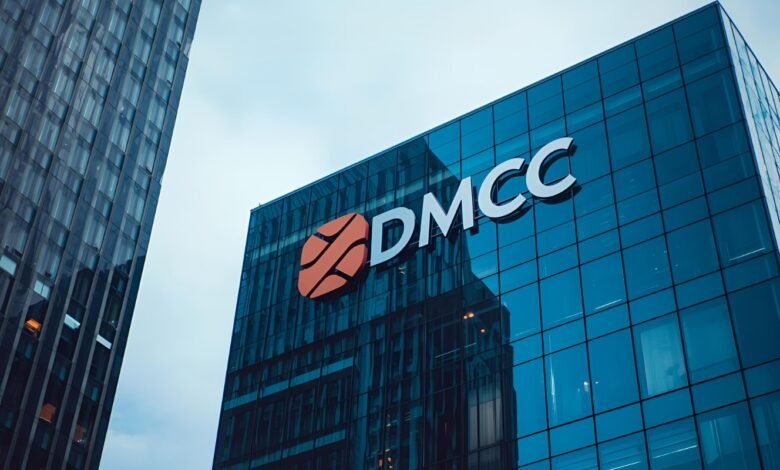DMCC Appoints NEB for World’s First Web3 Commercial Tower
DMCC Appoints NEB DMCC selects NEB to design and supervise Dubai’s landmark Web3 tower—setting a new global standard ....

In a move that underscores Dubai’s accelerating leadership in digital assets and decentralized technologies, the Dubai Multi Commodities Centre (DMCC) has appointed the National Engineering Bureau (NEB) as the design and supervision consultant for a pioneering Web3 commercial tower in Jumeirah Lakes Towers (JLT).
The project—often referenced as the “Crypto Tower”—aims to be the world’s first commercial tower dedicated to Web3 and digital assets, uniting startups, scale-ups, venture investors, and service providers across the blockchain ecosystem under one purpose-built roof. This appointment is more than a construction update; it is a strategic signal about the future of work in Web3, the infrastructure it will require, and the standards that will define it.
As Web3 matures from experimental pilots into enterprise-grade deployments, the built environment needs to evolve. Companies working on blockchain, DeFi, tokenization, digital identity, and AI-web3 convergence require spaces that are both technically advanced and regulatory-aware. By bringing NEB, a UAE-founded architectural and engineering stalwart with decades of regional experience, onto the project, DMCC and its development partner REIT Development are formalizing a blueprint for next-generation, compliance-friendly, and innovation-ready workplaces.
Why the NEB appointment matters for Web3’s built environment
The NEB appointment is significant for three intertwined reasons: it crystallizes the tower’s technical ambition, it professionalizes the delivery path, and it aligns the structure with Dubai’s long-term innovation agenda. DMCC Appoints NEB. NEB is known for combining architectural vision with engineering rigor in the Gulf region. Applying that capability to a Web3-focused office tower means the building can be designed around the unique needs of high-availability connectivity, secure data infrastructure, tiered access control, and compliance-first tenant operations—all while maintaining Dubai’s aesthetic and sustainability benchmarks.
In practical terms, the consultant role marries concept to execution. It ensures early-stage architectural decisions reflect future tenant realities: from how founders and quant developers use collaborative spaces, to where venture capital firms want proximity, to how regulatory audits might be supported on-site. DMCC Appoints NEB, NEB’s supervision also means that build quality and systems integration will be tracked closely through delivery, a critical factor for mission-critical enterprise tenants who value reliability as much as brand cachet.
DMCC’s strategic context: from licensing hub to physical ecosystem
Over the last several years, DMCC has evolved into one of the most active hubs for crypto and Web3 businesses, pairing business licensing with networking, accelerators, and ecosystem events. DMCC Appoints NEB. The Crypto Tower extends that strategy into the physical realm, clustering key players in a single address that is engineered for the industry’s specifications. By combining Grade-A office expectations with specialized digital asset features, DMCC is solving a pain point many Web3 firms face globally: finding space that is as security-conscious, compliance-ready, and infrastructure-rich as their workflows demand.
This trajectory also aligns with Dubai’s broader push to attract frontier-technology talent and capital. From hackathons to roadshows, the emirate has consistently showcased its intent to be a global hub for Web3 innovation. DMCC Appoints NEB. DMCC Appoints NEB. The tower offers a tangible, everyday expression of that policy—where ideas can graduate into companies, and companies into long-term economic contributors—without relocating beyond a campus optimized for blockchain-native operations.
Inside the “world’s first” Web3 commercial tower: what’s planned

Early information indicates the tower is planned as a mid-rise commercial building in JLT, emphasizing flexible office floors, incubator-ready levels, and spaces that can host venture capital, accelerators, and specialized service providers adjacent to core tenants. Reports indicate approximately 17 storeys and around 150,000 square feet of leasable space, with multiple floors earmarked for Web3 firms, incubators, and investment entities. TDMCC Appoints NEB. These allocations are designed to create a self-sustaining micro-ecosystem, shortening the distance between builders, backers, auditors, and advisors.
Beyond square footage, the concept connects the dots between technical readiness and community gravity. Expect backbone-grade connectivity, data-forward MEP planning, and provisions for secure collaboration, event hosting, and industry meetups that reflect Web3’s culture of open innovation. For tenants, that means a building where testnets, proofs-of-concept, and compliance checks can coexist with investor pitches, product launches, and developer workshops—all within a purpose-built, regulation-aware environment.
The role of Jumeirah Lakes Towers: location as strategy
Placing the tower within JLT is not incidental. The district already hosts a diverse mix of commercial tenants and benefits from connectivity to the rest of Dubai. DMCC Appoints NEB. For Web3 companies, proximity to DMCC’s existing operations, service providers, hotels, and transit is more than convenience; it’s an operational enabler. DMCC Appoints NEB. Being within walking or short driving distance of banks, compliance advisors, legal partners, and event venues turns the tower into an always-on hub rather than an isolated landmark.
From a branding perspective, JLT has the advantage of being recognized yet still evolving—ideal for a flagship asset that needs both visibility and room to shape its own identity. DMCC Appoints NEB. The area’s skyline is already dotted with distinctive commercial buildings; a Web3-dedicated tower adds a new chapter to that narrative, attracting international founders who want Dubai access without compromising grade-A workspace expectations.
Architecture for decentralization: how buildings can enable Web3
Decentralization isn’t just a technical principle; it has spatial implications. A building optimized for Web3 workflows will anticipate varied tenancy models, flexible floor plates, and security stratification. DMCC Appoints NEB. Think zones for hardware wallets and custody workflows, enclaves designed for confidential client work, and meeting rooms wired for hybrid collaboration with global teams across time zones. In a sector where smart contract audits, regulatory consultations, and token design sprints can occur in the same week, environmental adaptability is an asset.
NEB’s brief likely includes designing for redundant connectivity, power resilience, and mechanical systems that can support high-density usage without compromising comfort or sustainability. A Web3 tower should be as ready for a multi-team hackathon as it is for a board meeting with institutional allocators, toggling between public energy and private focus as the calendar demands.
The ecosystem promise: clustering builders, backers, and bridges
The core thesis behind the tower is ecosystem density. When founders, protocol teams, market makers, law firms, auditors, exchanges, and investors co-locate, information moves faster, and serendipity increases. Due diligence cycles compress. And communities—developer guilds, DeFi working groups, tokenomics study clubs—gain a place to form and persist. DMCC Appoints NEB. This is how innovation districts worldwide amplify outcomes, and why a Web3-specific commercial tower can be more than symbolic. It’s a productivity engine configured for digital asset businesses.
Such clustering is already reflected in DMCC’s programmatic efforts, from hackathons to demo days and roadshows. The tower acts as a year-round anchor for those activities, giving global visitors an address to plug into, and local teams a home base from which to scale. DMCC Appoints NEB. In an industry where network effects often make the difference between breakout and stagnation, physical proximity to the right partners can be decisive.
Tenant advantages: what Web3 companies gain on day one

A company leasing space in a Web3-dedicated building stands to gain advantages that a generic office can’t match. First, brand positioning: being in a landmark recognized for digital assets conveys credibility to clients and investors. Second, operational readiness: the tower’s infrastructure is likely tuned for always-on connectivity, secure network segmentation, and oversight-friendly access controls. Third, recruitment and retention: employees—especially developers and product managers—benefit from being embedded in a vibrant, like-minded community with regular events and informal learning loops.
Add to that the support systems DMCC is known to facilitate—licensing pathways, introductions to partners, and event platforms—and you get a compelling total value proposition for both startups and enterprise Web3 initiatives looking to establish a Middle East hub. For venture capital and family offices, the tower centralizes deal flow and due diligence, enabling faster evaluations and targeted support for portfolio companies on-site.
Security and compliance by design: DMCC Appoints NEB
One of the most underappreciated benefits of a sector-specific building is embedded compliance thinking. From how visitor management is handled to where sensitive conversations occur, physical protocols complement digital security. Expect a design approach that anticipates regulatory inspections, supports audit trails, DMCC Appoints NEB, and integrates KYC/KYB-friendly workflows into shared amenities without sacrificing tenant privacy. For Web3 firms courting institutional partners, being able to demonstrate that security and compliance are part of the premises—not bolted on—can accelerate enterprise adoption.
This is especially important for firms seeking to combine DeFi primitives with TradFi standards, where the bar for custody, reporting, and controls is higher. DMCC Appoints NEB. A building engineered for those expectations becomes a differentiator in competitive fundraising, enterprise sales, and cross-border partnerships.
The Dubai effect: policy clarity meets physical infrastructure
Dubai’s rise as a digital-asset-friendly jurisdiction is no accident. The emirate’s approach—combining regulatory clarity, business-friendly processes, and world-class infrastructure—has become a magnet for global builders. DMCC Appoints NEB. The Web3 commercial tower embodies this formula in brick and glass. For multinational firms weighing their regional strategy, the message is simple: set up here, plug into a ready-made ecosystem, and move faster than the market.
The tower also pairs well with Dubai’s existing assets: international connectivity, time zone advantages bridging Asia, Europe, and Africa, and a cosmopolitan talent pool. DMCC Appoints NEB. When you add a dedicated Web3 address to this mix, the city’s gravitational pull on blockchain professionals and crypto-native enterprises intensifies.
From concept to catalyst: what the market should watch
With NEB on board as design and supervision consultant, several milestones will be worth tracking: the release of final architectural renders, announcements of anchor tenants, details on floor-by-floor programming (e.g., incubators, venture, AI, or R&D), and the go-to-market strategy for leasing.
Observers should also watch how the tower integrates with DMCC’s event calendar—demo days, hackathons, and industry summits that convert short-term visitors into long-term tenants. If the building executes on its promise, it could redefine what “crypto-friendly real estate” looks like worldwide—focusing less on speculative branding and more on operational excellence, security, and ecosystem density. DMCC Appoints NEB. Copycats will likely emerge in other innovation hubs, but being the first at a global scale gives Dubai a definitive narrative advantage.
NEB’s pedigree and what it signals
NEB’s selection telegraphs a commitment to delivery discipline. Founded in the UAE in 1984, the firm has cultivated a track record across architecture, engineering, supervision, and project management in the region. DMCC Appoints NEB, Translating that experience to a Web3-first commercial tower means the project will be informed by local building codes, climate considerations, and user expectations specific to Dubai—ensuring an outcome that is both globally ambitious and regionally intelligent.
For tenants and investors, that pedigree reduces execution risk. It suggests that wise design choices—such as future-proofing for evolving hardware, provisioning for next-gen connectivity standards, and sustainability certifications—will be considered early, not retrofitted later.
A blueprint others can adopt: DMCC Appoints NEB
The implications of DMCC’s move extend beyond Dubai. As more cities seek a stake in the tokenized economy, they face a question: how do you transform policy intent into a daily operating reality for Web3 companies? This tower offers a playbook: combine a pro-business regulator, an ecosystem operator (DMCC), and a seasoned consultant (NEB) to create an asset that is attractive on day one and adaptable for year five. It’s a model that can be localized—whether in Singapore, Hong Kong, Frankfurt, or Miami—while preserving the core insight that space design shapes innovation outcomes.
What founders should consider now?
If you’re a founder weighing a Dubai presence, start mapping your space requirements against the tower’s rumored programming: proximity to incubators, access to investors, and the potential for co-creation with adjacent tenants. DMCC Appoints NEB. Consider how customer trust might be strengthened by an address associated with security, compliance, and institutional-grade operations. If your roadmap touches tokenization, DeFi, NFT infrastructure, on-chain identity, or AI + Web3, the ability to participate in a dense, curated community could raise your surface area for serendipity—and accelerate product-market fit.
Investor lens: deal flow at your doorstep
For investors—venture capital, family offices, corporate venture arms—the tower offers efficient deal discovery. With builders, auditors, and service providers one elevator ride apart, pipeline vetting is faster, and post-investment support is more hands-on. DMCC Appoints NEB. Demo days, office hours, and impromptu working sessions take place without the frictions of citywide logistics. Over time, this dynamic can produce ecosystem resilience, where knowledge circulates and best practices compound across portfolios.
The brand narrative: why “world’s first” matters
Claiming the mantle of world’s first Web3 commercial tower is powerful storytelling—but it’s also a market-making act. It sets expectations for what amenities, security, and community features a Web3 tenant should demand. It defines a category. DMCC Appoints NEB. And it forces competitors to raise their game, benefiting companies worldwide. DMCC Appoints NEB. Dubai’s move, anchored by DMCC and professionalized by NEB, signals to founders and investors that the city isn’t just friendly to Web3—it’s architecting the spaces where the next wave of decentralized innovation will be built.
Conclusion
DMCC’s appointment of NEB as consultant for the world’s first Web3 commercial tower is a watershed moment for the industry’s physical infrastructure. It validates the idea that Web3 deserves purpose-built real estate—spaces where connectivity, security, compliance, and community are designed in from the start. Situated in JLT, backed by DMCC’s ecosystem, and guided by NEB’s engineering discipline, the tower is poised to become a global reference point for how and where decentralized technologies get built at scale. For founders, investors, and enterprise adopters, it offers not just an address—but an advantage.
FAQs
Q: What exactly makes this a “Web3 commercial tower”?
It’s a purpose-built office building designed for companies working in blockchain, DeFi, tokenization, and adjacent fields. Floor programming, connectivity, security, and amenities are tailored to Web3 operating needs, including proximity to incubators, investors, and specialized service providers.
Q: Where will the tower be located?
The tower is planned for Jumeirah Lakes Towers (JLT) in Dubai—an established commercial district that provides excellent connectivity, hospitality options, and access to DMCC’s broader ecosystem.
Q: Who is NEB and what is their role?
NEB (National Engineering Bureau) is a UAE-founded architectural and engineering firm appointed as the design and supervision consultant. DMCC Appoints NEB. NEB will help translate the Web3-focused concept into a deliverable building that meets regional standards while supporting the sector’s technical and compliance needs.
Q: How big is the project, and what facilities are expected?
Reports indicate a 17-storey building with around 150,000 square feet of leasable space, including multiple floors dedicated to Web3 companies, incubators, and venture capital. The concept emphasizes high-availability connectivity, secure collaboration zones, and community-centric event spaces.
Q: Why is DMCC investing in a physical tower for Web3?
DMCC is evolving from licensing and ecosystem programming to purpose-built infrastructure that speeds up innovation cycles. A dedicated tower concentrates deal flow, talent, and support services, helping Web3 firms scale faster and giving Dubai a durable edge as a global hub for digital assets.
See More: KuCoin Web3 Wallet Baby Shark Universe Entertainment Meets Web3




